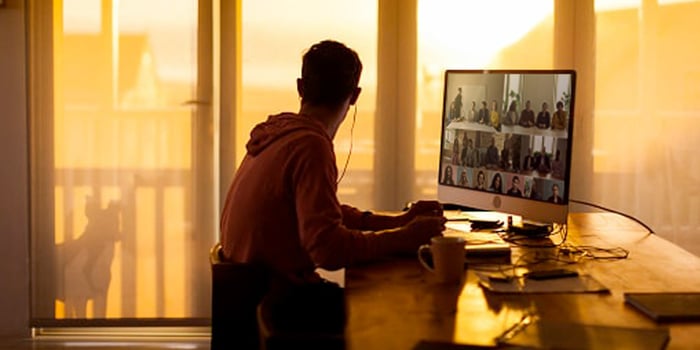Video conferencing — with video on — is a visual medium, which means that spending some time optimizing your home office lighting can help you to present yourself at your best while making it easier for others to see you, too.
In this article you will learn some video conference lighting top tips to help you optimize your home office environment.
- Pre-video meeting lighting preparation
- Quick guide to lighting fixes
- Video conference lighting technology tips
- The Hoffice video - 'how to get the most of your home office: lighting'
Lighting for video conferencing
It's not enough for you to be able to see everyone else clearly; you need to show the same attention to how you appear to others. This reduces the potential for fatigue and enables a better overall video meeting experience.
At the same time, good lighting helps build confidence. Knowing you’ve invested time into your set-up means you can present like a pro and ensure that you can focus on delivering a compelling message or presentation.

Prepare: light up your video conferencing game before the call
Lighting is just like every other part of your work from home set-up — it’s something to test before you start the call. Sitting on the call and seeing that you’re coming across as a wispy shadow or looming silhouette is not the time to start rearranging your lighting. Don’t risk being the person who spends 10 distracting minutes adjusting lamps and blinds while everyone politely ignores it and tries to focus on the agenda.
Consider where you place your camera, making sure you don’t have it pointing out to a window. Most cameras don’t deal well with a light source behind them. When this happens, what your audience sees is too much light and not enough you.
The same principle applies when light is focused at one side of your face. This will result in an imbalance, with one side darker than the other. Or, if the lighting is directly above your head, it can cast shadows and worse, light streaks down your face.
Try switching your light source so it’s in front of you to avoid these kinds of issues.
A quick guide to lighting fixes
Natural light is not always a friend to video conferencing. If you don't have blackout blinds (that actually work), you can't control the natural light and your call quality is at the mercy of the sun and clouds. The technology will usually keep trying to compensate for the light changes, which means inconsistent video quality.
When relying on your normal room lighting, check that nearby light sources are bright enough. Do some testing across devices to see if you’re creating a shadowy effect and where the high and low lights need some adjusting.
For my own work from home set-up, I started with the brightest LED bulbs I could get (which are available from your local hardware store) so I knew that I was starting with the best possible source from the ceiling lights. Then experimented with sources such as desk lamps to ensure that I was as bright as I should be on the screen.
Pushed by the gaming industry — where gamers use video conferencing on platforms like Twitch and Steam — we’re starting to see webcams with built-in LED rings. This is ideal for all types of users, but it’s an indication that lighting for video and video conferencing is a serious business. Ring lights can be very effective in helping you be seen in a good light, and might be an option to consider if you’re frequently on video calls.
For more tips on how to set up your camera to ensure high-quality video meetings, watch this 2 minute video. Or watch ‘The Hoffice - how to get the most of your home office’ video series, covering audio, lighting, backdrops and environment.






